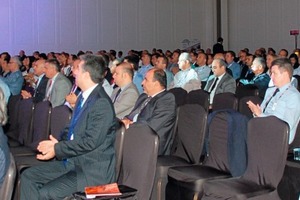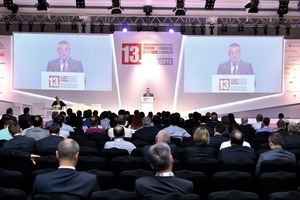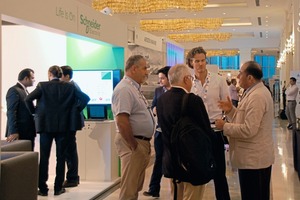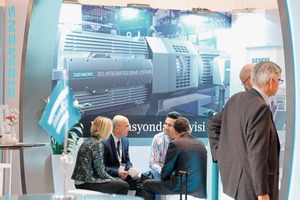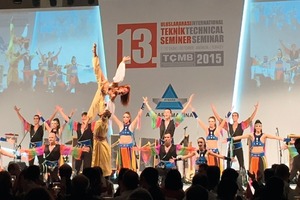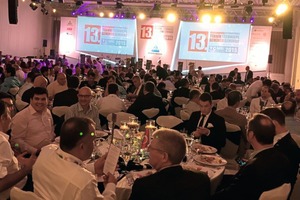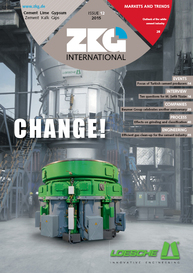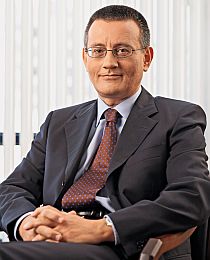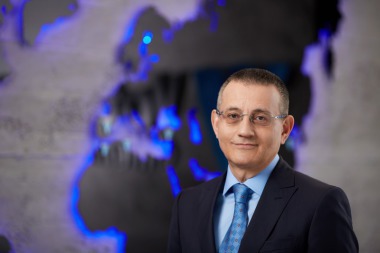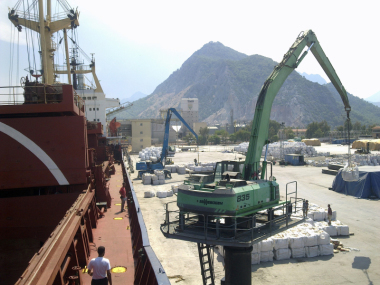Sustainable cement production the focus of Turkish cement producers
From 07.10.-10.10.2015, more than five hundred participants gathered in Antalya/Turkey to exchange information and opinions on the Turkish cement industry and the latest discoveries from practice and research at the 13th TÇMB, International Technical Seminar and Exhibition. Just on one hundred exhibitors took the opportunity of showcasing their products and services, and of providing information on current projects, at the accompanying exhibition. This industry forum, perfectly organised down to the last detail by the Turkish Cement Manufacturers’ Association, also offered numerous opportunities for intensive interchange of experience between specialist colleagues.
M. Şefik Tüzün, Chairman of the Board of the Turkish Cement Manufacturers’ Association, emphasised in his speech of welcome the aim of the event, held for the first time in 1987 and now recurring biennially, of disseminating knowledge on the technology of cement production. As he noted, the TÇMB aspires to bring Turkish cement producers and subsuppliers together as a communications platform. Topics such as environmental protection and sustainability, energy-savings, low-carbon technologies, alternative fuels and feed materials, industrial safety and high product quality are important current topics on the Turkish cement industry’s agenda. As Tüzün states: “With 52 integrated and in total 70 production units, the Turkish cement industry stands at the focal point of the national economy and the world cement business; Turkey ranks first in Europe and fifth in the world in cement production”. A key industry in Turkey, the cement industry employs some 50 000 people. The prospects are good: seven million existing buildings are to be renovated during the next twenty years, 1.7 million of them in Istanbul alone. More detailed information on the Turkish cement industry can be found in our interview with M. Şefik Tüzün starting on page 16.
“The 13th International Technical Seminar reflects the deep and long-standing relationship between the AUCBM and TCMA, and, in particular, the fact that Turkey and the Arab countries constitute an important region, where the cement industry and cement production have developed significantly, and also their prominent geographical location, close to Europe, Africa and the rest of the world”, noted Eng. Ahmad Al-Rousan, AUCBM, Secretary General, in his welcoming address: “The topics highlight important issues in the cement industry, including carbon reduction technologies and the use of municipal and industrial waste, which, in turn, achieve sustainable development of the industry. Within the scope of the Arab cement industry, it has developed remarkably over recent years; the number of factories amounted to 164 plants and 21 mills, and nominal capacities registered 340 million t, 153 million t of which were in the Arab Mashreq countries and 126 million t in the GCC countries. Actual production reached 214 million t in 2014, and total consumption was 234 million t. It is expected that consumption will decrease during 2015 and 2016 due to the difficult conditions experienced in countries such as Iraq, Libya, Syria, and Yemen, as well as the decline in oil prices, in addition to other economic circumstances. This will mostly lead to the cancellation of some planned projects, especially in the GCC countries.
Imports reached 43 million t, and went mainly to Algeria, Iraq and Saudi Arabia; however, they have started to decline. Exports registered 19 million t and the per capita consumption rate was 1700 kg of cement in Algeria, Egypt, GCC countries, Iraq, Jordan, Lebanon, Morocco, Tunisia; and it reached 185 kg in the remainder of the Arab countries. Most cement factories and companies are owned by the local public sector, while 23 % of the industry is owned by major international companies, in varying proportions”.
Koen Coppenholle, CEO of Cembureau, emphasised in his remarks that the predominant topic in the European cement industry are both the reduction of CO2 emissions and the efficient use of energy. The cement industry, he affirmed, is highly committed to the reuse of waste from other industries as feed materials, in the form, for example, of alternative fuels, and is thus promoting the targeted “circular economy”. The cement sector, as a capital-intensive local industry, makes a significant contribution to regional development, to employment and to economic growth. As he noted, global cement production in 2014 was some 4.3 billion t, of which 56.5 % alone was produced in China. For the purpose of comparison: Cembureau produced 5.5 %, Africa 4.8 %, India 7.0 %, Asia (not including China, Japan and India) 15.5 % and America (including the USA) 6.5 %.
Aisha Elaine Williams, Country Manager for Turkey, World Bank Group IFC, focussed in her speech on investment in sustainable projects in the cement industry, and illustrate, citing examples such as Cimko Cement, Turkey, potentials for the financing of a range of different projects.
Ashwani Pahuja, Director General, National Council for Cement and Building Materials, India, spoke on the situation in the Indian cement industry; interested readers will find his report, starting on page 24.
The subsequent corporate presentations and specialist papers on the two-day agenda examined a broad bandwidth of topics, ranging from the use of alternative fuels, and chemical additives for the reduction of CO2, energy-saving grinding technologies, maintenance, optimised use of energy, up to and including the reduction of NOx emissions.
The accompanying exhibition was well frequented during the breaks, also providing an opportunity for exchange of opinions on the preceding papers and for discussion of new projects, among other things.
The event closed with a gala dinner, the grandiose accompanying cultural and entertainment programme, which almost magically levitated the around 500 attendant guests from their seats. The 14th TÇMB will be held in 2017.
//www.tcma.org.tr" target="_blank" >www.tcma.org.tr:www.tcma.org.tr

